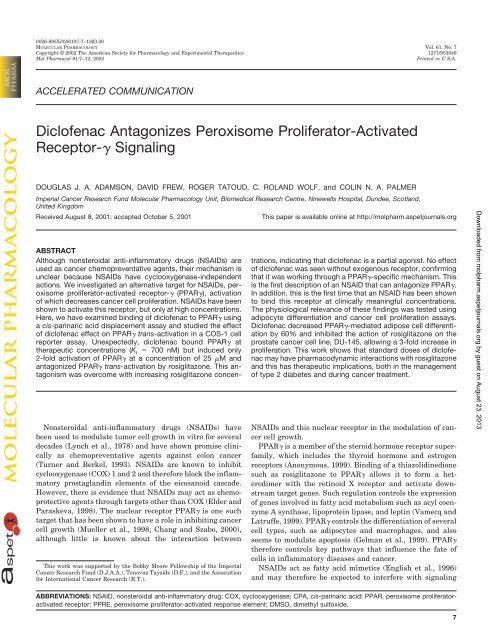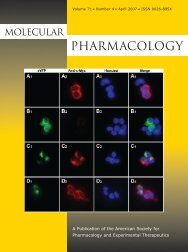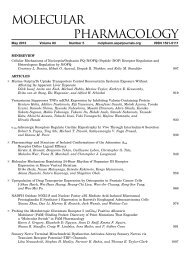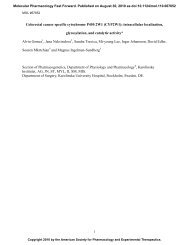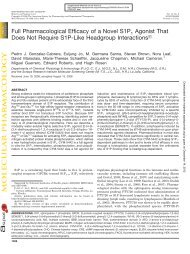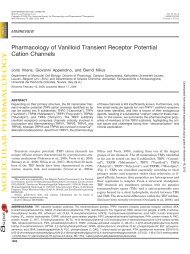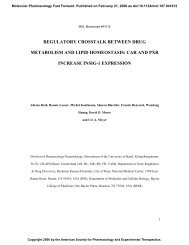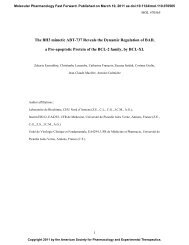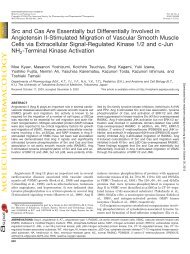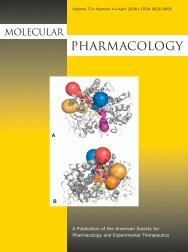Diclofenac Antagonizes Peroxisome Proliferator-Activated Receptor ...
Diclofenac Antagonizes Peroxisome Proliferator-Activated Receptor ...
Diclofenac Antagonizes Peroxisome Proliferator-Activated Receptor ...
You also want an ePaper? Increase the reach of your titles
YUMPU automatically turns print PDFs into web optimized ePapers that Google loves.
0026-895X/02/6107-7–12$3.00<br />
MOLECULAR PHARMACOLOGY Vol. 61, No. 7<br />
Copyright © 2002 The American Society for Pharmacology and Experimental Therapeutics 1277/953849<br />
Mol Pharmacol 61:7–12, 2002<br />
Printed in U.S.A.<br />
ACCELERATED COMMUNICATION<br />
<strong>Diclofenac</strong> <strong>Antagonizes</strong> <strong>Peroxisome</strong> <strong>Proliferator</strong>-<strong>Activated</strong><br />
<strong>Receptor</strong>- Signaling<br />
DOUGLAS J. A. ADAMSON, DAVID FREW, ROGER TATOUD, C. ROLAND WOLF, and COLIN N. A. PALMER<br />
Imperial Cancer Research Fund Molecular Pharmacology Unit, Biomedical Research Centre, Ninewells Hospital, Dundee, Scotland,<br />
United Kingdom<br />
Received August 8, 2001; accepted October 5, 2001<br />
This paper is available online at http://molpharm.aspetjournals.org<br />
Nonsteroidal anti-inflammatory drugs (NSAIDs) have<br />
been used to modulate tumor cell growth in vitro for several<br />
decades (Lynch et al., 1978) and have shown promise clinically<br />
as chemopreventative agents against colon cancer<br />
(Turner and Berkel, 1993). NSAIDs are known to inhibit<br />
cyclooxygenase (COX) 1 and 2 and therefore block the inflammatory<br />
prostaglandin elements of the eicosanoid cascade.<br />
However, there is evidence that NSAIDs may act as chemoprotective<br />
agents through targets other than COX (Elder and<br />
Paraskeva, 1998). The nuclear receptor PPAR is one such<br />
target that has been shown to have a role in inhibiting cancer<br />
cell growth (Mueller et al., 1998; Chang and Szabo, 2000),<br />
although little is known about the interaction between<br />
This work was supported by the Bobby Moore Fellowship of the Imperial<br />
Cancer Research Fund (D.J.A.A.), Tenovus Tayside (D.F.), and the Association<br />
for International Cancer Research (R.T.).<br />
ABSTRACT<br />
Although nonsteroidal anti-inflammatory drugs (NSAIDs) are<br />
used as cancer chemopreventative agents, their mechanism is<br />
unclear because NSAIDs have cyclooxygenase-independent<br />
actions. We investigated an alternative target for NSAIDs, peroxisome<br />
proliferator-activated receptor- (PPAR), activation<br />
of which decreases cancer cell proliferation. NSAIDs have been<br />
shown to activate this receptor, but only at high concentrations.<br />
Here, we have examined binding of diclofenac to PPAR using<br />
a cis-parinaric acid displacement assay and studied the effect<br />
of diclofenac effect on PPAR trans-activation in a COS-1 cell<br />
reporter assay. Unexpectedly, diclofenac bound PPAR at<br />
therapeutic concentrations (K i 700 nM) but induced only<br />
2-fold activation of PPAR at a concentration of 25 M and<br />
antagonized PPAR trans-activation by rosiglitazone. This antagonism<br />
was overcome with increasing rosiglitazone concentrations,<br />
indicating that diclofenac is a partial agonist. No effect<br />
of diclofenac was seen without exogenous receptor, confirming<br />
that it was working through a PPAR-specific mechanism. This<br />
is the first description of an NSAID that can antagonize PPAR.<br />
In addition, this is the first time that an NSAID has been shown<br />
to bind this receptor at clinically meaningful concentrations.<br />
The physiological relevance of these findings was tested using<br />
adipocyte differentiation and cancer cell proliferation assays.<br />
<strong>Diclofenac</strong> decreased PPAR-mediated adipose cell differentiation<br />
by 60% and inhibited the action of rosiglitazone on the<br />
prostate cancer cell line, DU-145, allowing a 3-fold increase in<br />
proliferation. This work shows that standard doses of diclofenac<br />
may have pharmacodynamic interactions with rosiglitazone<br />
and this has therapeutic implications, both in the management<br />
of type 2 diabetes and during cancer treatment.<br />
NSAIDs and this nuclear receptor in the modulation of cancer<br />
cell growth.<br />
PPAR is a member of the steroid hormone receptor superfamily,<br />
which includes the thyroid hormone and estrogen<br />
receptors (Anonymous, 1999). Binding of a thiazolidinedione<br />
such as rosiglitazone to PPAR allows it to form a heterodimer<br />
with the retinoid X receptor and activate downstream<br />
target genes. Such regulation controls the expression<br />
of genes involved in fatty acid metabolism such as acyl coenzyme<br />
A synthase, lipoprotein lipase, and leptin (Vamecq and<br />
Latruffe, 1999). PPAR controls the differentiation of several<br />
cell types, such as adipocytes and macrophages, and also<br />
seems to modulate apoptosis (Gelman et al., 1999). PPAR<br />
therefore controls key pathways that influence the fate of<br />
cells in inflammatory diseases and cancer.<br />
NSAIDs act as fatty acid mimetics (English et al., 1996)<br />
and may therefore be expected to interfere with signaling<br />
Downloaded from molpharm.aspetjournals.org by guest on August 23, 2013<br />
ABBREVIATIONS: NSAID, nonsteroidal anti-inflammatory drug; COX, cyclooxygenase; CPA, cis-parinaric acid; PPAR, peroxisome proliferatoractivated<br />
receptor; PPRE, peroxisome proliferator-activated response element; DMSO, dimethyl sulfoxide.<br />
7
8 Adamson et al.<br />
pathways such as the PPAR family of fatty acid-activated<br />
transcription factors. Indomethacin, fenoprofen, and ibuprofen<br />
activate PPAR at concentrations of 50 to 500 M and<br />
inhibit the production of monocyte inflammatory cytokines in<br />
vitro (Jiang et al., 1998). Such NSAIDs may activate PPAR<br />
at the concentrations achieved during high-dose therapy for<br />
rheumatoid disease; however, there have been no reports of<br />
NSAIDs binding PPAR with high affinity or acting as an<br />
antagonist of this receptor.<br />
PPAR is therefore a likely alternative target for NSAID<br />
action, but this has not been extensively investigated. We<br />
therefore examined a range of NSAIDs for their ability to<br />
modulate PPAR signaling. Here, we show that the widely<br />
used analgesic diclofenac binds PPAR at clinically relevant<br />
concentrations and also antagonizes PPAR trans-activation<br />
in a receptor-dependent manner, producing distinct physiological<br />
effects.<br />
Experimental Procedures<br />
Materials. Unless stated otherwise, chemicals were obtained<br />
from Sigma-Aldrich Company Ltd. (Poole, UK) and solvents from<br />
BDH Laboratory Supplies (Poole, UK). cis-Parinaric acid (CPA) was<br />
obtained from Molecular Probes (Leiden, The Netherlands).<br />
Measurement of the Affinity of NSAIDs for PPAR. The<br />
affinity of the NSAIDs fenoprofen and diclofenac for PPAR was<br />
measured using a spectrophotometric binding assay as described<br />
previously (Palmer and Wolf, 1998). Briefly, CPA is a ligand for<br />
PPAR and its absorption spectrum changes on binding this receptor.<br />
When CPA is displaced from PPAR by a competitor for the<br />
binding site, its spectrum returns to that of the unbound state and<br />
the IC 50 of the competitor can be determined. The magnitude of the<br />
spectral shift is quantified by determining the ratio of the absorbencies<br />
at 319 nm and 329 nm. The A 319 nm /A 329 nm ratio of CPA in<br />
solution is between 2.6 and 3, and the ratio for CPA, when fully<br />
bound to the receptor, is 1. cis-Parinaric acid was added to 25 mM<br />
Tris-HCl, pH 7.5, at room temperature and scanned against buffer<br />
between 312 nm and 340 nm, using a UV-3000 scanning spectrophotometer<br />
(Shimadzu Scientific Instruments, Inc., Columbia, MD).<br />
Subsequent additions of protein (purified hPPAR LBD) and competitor<br />
were added equally to both sample and reference cuvettes.<br />
When bound to PPAR, cis-parinaric acid produces fluorescence<br />
that is diminished when the fatty acid is displaced by a competitor.<br />
Therefore, a modified assay can be used in addition to the one<br />
described above to determine the K i values of ligands with an affinity<br />
in the nanomolar range. Such an assay was carried out with diclofenac<br />
using 200 nM CPA and 250 nM recombinant hPPAR LBD.<br />
These concentrations are well below the K d value of cis-parinaric acid<br />
and therefore avoid the spurious results caused by the stoichiometric<br />
binding seen when the experiment is performed in the presence of<br />
concentrations of protein and cis-parinaric acid that are above their<br />
K d values. Fluorescence was measured using an excitation wavelength<br />
of 318 nm and emission wavelength of 410 nm with an LS-3<br />
fluorescence spectrophotometer (PerkinElmer Life Sciences, Cambridge,<br />
UK). The sum of the fluorescence produced by the protein<br />
alone and the CPA alone were deducted from the measured value.<br />
The EC 50 was determined using a single site displacement model and<br />
the K i value was calculated using the equation K i EC 50 /(1<br />
[ligand] / K d ) (Prism for Macintosh version 3.0a; GraphPad Software,<br />
San Diego, CA).<br />
Cell Culture. Dulbecco’s modified Eagle’s medium (high glucose)<br />
supplemented with 9% fetal calf serum, 45 IU/ml penicillin G, and 45<br />
g/ml streptomycin was used except where stated otherwise. Cells<br />
were grown in an atmosphere of 5% carbon dioxide. Cell culture<br />
reagents were obtained from Invitrogen (Paisley, UK).<br />
trans-Activation Assay. COS-1 cells were seeded in six-well<br />
plates (Iwaki Glass Co., Ltd., Funabashi-shi Chiba-ken, Japan) at<br />
3 10 5 per well. The following day they were transfected with an<br />
expression vector for hPPAR (50 ng per well), a luciferase reporter<br />
construct (500 ng), and an internal -galactosidase control vector<br />
(500 ng), using a DEAE-dextran method (Cullen, 1987). The vector<br />
pCLDN (Brighty et al., 1991) was used to express full-length hP-<br />
PAR1 protein. The NSAID activation experiments used the LFAB-<br />
P(DR1) 4 -TK-GL3 reporter vector [containing four copies of the liver<br />
fatty-acid binding peroxisome proliferator response element (PPRE)<br />
upstream of a luciferase reporter driven by a thymidine kinase<br />
promoter], which was a gift from GlaxoSmithKline (Welwyn Garden<br />
City, UK). The internal control plasmid, p-SV--galactosidase, was<br />
obtained from Promega Corporation (Southampton, UK). Drugs (except<br />
rosiglitazone, which was a gift of GlaxoSmithKline) were obtained<br />
from Sigma-Aldrich, dissolved in DMSO, and added to cell<br />
culture medium to give a final DMSO concentration of 0.1% in all<br />
experiments. The day after transfection, the cells were exposed to<br />
drug for 18 h and underwent lysis the following day. Luciferase<br />
expression was quantified by measuring the activity of luciferase<br />
with a TD-20/20 luminometer (Turner Designs, Inc., Sunnyvale, CA)<br />
using luciferase assay reagent (E1501; Promega). The luciferase<br />
reading was divided by the -galactosidase activity (E2000 -galactosidase<br />
enzyme assay system, 96-well format; Promega) from the<br />
same replicate to correct for the transfection efficiency.<br />
Adipogenesis Assay. Preadipocytes (3T3-L1) were grown to confluence<br />
in an atmosphere of 10% CO 2 . Forty-eight hours after confluence,<br />
the cells were treated for six consecutive days, changing the<br />
medium and drugs every second day. Rosiglitazone, with and without<br />
diclofenac, was added, along with 5 g/ml of insulin (Sigma) and<br />
1 M dexamethasone (Sigma). DMSO alone was used as a control.<br />
The degree of differentiation was examined by staining with the<br />
lipid-soluble dye Oil Red O (Sigma) as described previously<br />
(Ramírez-Zacarías et al., 1992). Representative areas of staining<br />
were photographed and the amount of lipid accumulation was quantified<br />
by extracting the dye with isopropanol and measuring the<br />
absorbance at 510 nm.<br />
Prostate Cancer Cell Growth Assay. Prostate cancer cells<br />
(DU-145) were plated at 2000 cells per well on 24-well plates (Iwaki)<br />
in RPMI 1640 medium supplemented with 10% fetal calf serum and<br />
2 mM glutamine. After 24 h, the medium was replaced by RPMI 1640<br />
medium without phenol red, supplemented with 5% dextran-charcoal<br />
(Sigma) treated fetal calf serum with 2 mM glutamine. Treatments<br />
were with 10 M rosiglitazone, 25 M diclofenac, or a combination<br />
of both drugs. The medium was replaced every second day<br />
with fresh drug-containing medium. After 6 days of treatment, cell<br />
number was measured by a colorimetric assay based on the activity<br />
of lysosomal hexosaminidase (Landegren, 1984).<br />
Statistical Analysis. Data were analyzed using GraphPad<br />
Prism. The trans-activation assay results in Figs. 2A and 3B were<br />
analyzed by one-way ANOVA using Dunnett’s post test to compare<br />
the results with the DMSO control. ANOVA with no post test was<br />
used to analyze the data in Fig. 2B. The Oil Red O extraction data<br />
and the results of the prostate cancer growth assay were analyzed by<br />
one-way ANOVA, using Tukey’s multiple comparison post test to<br />
compare the drugs effects with each other and with the control. The<br />
significance of the effect of diclofenac on rosiglitazone action was<br />
analyzed by unpaired, two-tailed t tests at each dose of rosiglitazone.<br />
Statistical significance was defined as a p value of 0.05 or less.<br />
Results<br />
<strong>Diclofenac</strong> Has an Affinity for PPAR 50 Times<br />
Greater Than Those Reported for Other NSAIDs.<br />
PPAR has been suggested as an alternative target for<br />
NSAID action. Therefore, we examined a range of NSAIDs<br />
for their ability to modulate PPAR signaling. To assess the
<strong>Diclofenac</strong> <strong>Antagonizes</strong> PPAR Signaling 9<br />
binding of NSAIDs to PPAR, we used a spectrophotometric<br />
assay examining the displacement of CPA from the ligandbinding<br />
domain of PPAR. Consistent with previous reports,<br />
fenoprofen displaced CPA at relatively high concentrations<br />
(100 M). Surprisingly, diclofenac displaced CPA in a stoichiometric<br />
fashion (Fig. 1A); i.e., the cis-parinaric acid was<br />
present at 1.5 M in this assay and the diclofenac displaced<br />
the cis-parinaric acid with an EC 50 of 1.6 M. This experiment<br />
suggested that the K i value of diclofenac for PPAR was<br />
below 1.5 M. The binding of diclofenac to PPAR was further<br />
examined using a fluorescence-based assay, which allowed<br />
the use of lower concentrations of cis-parinaric acid.<br />
These assays demonstrated that diclofenac displaced CPA<br />
from PPAR with a K i value of 700 nM (Fig. 1B). Therefore,<br />
diclofenac has an affinity for PPAR more than fifty times<br />
greater than has been previously reported for an NSAID<br />
(Lehmann et al., 1997) and about four times greater than the<br />
putative endogenous ligand, 15-deoxy- 12,14 -prostaglandin J 2<br />
(Forman et al., 1995).<br />
<strong>Diclofenac</strong> Is a Weak PPAR Agonist and <strong>Antagonizes</strong><br />
PPAR trans-Activation. We employed a trans-activation<br />
assay to measure the effect of diclofenac on the<br />
function of the PPAR receptor. The assay was validated<br />
using known PPAR agonists, which caused activation of the<br />
reporter gene at the expected concentrations: rosiglitazone at<br />
500 nM [6.6-fold activation over control, p 0.05] and the<br />
NSAID indomethacin at 500 M [7.5-fold, p 0.05] (Fig. 2A).<br />
Despite its relatively high affinity for PPAR, diclofenac (25<br />
M) induced only 2-fold activation of the reporter gene (Fig.<br />
2A). In the absence of exogenous PPAR receptor, increasing<br />
doses of diclofenac induced no reporter gene activation,<br />
whereas in the presence of receptor, a significant but small<br />
response to the higher doses was seen [p 0.05] (Fig. 2B).<br />
Concentrations of diclofenac greater than 30 M were toxic<br />
to the COS-1 cells, causing a progressive decrease in the<br />
-galactosidase activity (data not shown). We then tested<br />
whether diclofenac could antagonize the PPAR agonist rosiglitazone.<br />
The dose-response for rosiglitazone was attenuated<br />
in the presence of 10 M diclofenac (Fig. 3A). As would<br />
be expected for a competitive partial agonist, this inhibition<br />
was overcome at saturating doses of rosiglitazone, with the<br />
statistical difference between the two treatments disappearing<br />
at 500 nM rosiglitazone. The reporter gene activation by<br />
rosiglitazone is PPAR-specific, as can be seen from the results<br />
of the same experiment when carried out using the<br />
expression vector pCLDN as a control (Fig. 3A, open symbols).<br />
This confirmed minimal reporter gene activity in the<br />
absence of exogenous PPAR. These results show that, unlike<br />
indomethacin, which acts as a complete agonist at high<br />
concentrations, diclofenac inhibits PPAR signaling and can<br />
significantly reduce reporter gene activation by rosiglitazone.<br />
Increasing concentrations of diclofenac caused increasingly<br />
significant inhibition of rosiglitazone trans-activation (Fig.<br />
3B).<br />
To test whether diclofenac could alter the physiological<br />
effects of PPAR signaling, we used two separate in vitro<br />
bioassays of rosiglitazone action. First, we used the 3T3-L1<br />
Fig. 1. <strong>Diclofenac</strong> binds to PPAR at low concentrations. A, spectral shift<br />
binding assay. <strong>Diclofenac</strong> (f) binds PPAR at low concentrations, similar<br />
to the concentration of protein used in this assay. Fenoprofen (Œ) has<br />
much weaker affinity. B, fluorescence displacement assay, using lower<br />
concentrations of protein. <strong>Diclofenac</strong> has an IC 50 of 700 nM.<br />
Fig. 2. <strong>Diclofenac</strong> is a weak activator of PPAR. A, the effect of different<br />
NSAIDs on trans-activation of a PPRE-containing reporter construct by<br />
PPAR in COS-1 cells. The effects of 500 nM rosiglitazone (Rosiglit), 500<br />
M indomethacin (Indo), 25 M diclofenac (Dic), or DMSO control are<br />
shown. Error bars are S.E.M. *, p 0.05; ns, not significant compared<br />
with control. B, in the absence of exogenous PPAR receptor, increasing<br />
doses of diclofenac induce no reporter gene activity. In the presence of<br />
exogenous receptor, the highest doses of diclofenac induce reporter gene<br />
activation of approximately 1.5-fold, p 0.05. Error bars are S.E.M.
10 Adamson et al.<br />
Fig. 3. <strong>Diclofenac</strong> acts as a partial agonist of PPAR. A, the effect of 10<br />
M diclofenac (f) on rosiglitazone-mediated trans-activation was compared<br />
with that induced by rosiglitazone alone (F). Reporter assays were<br />
performed in the presence (filled symbols) or absence (open symbols) of<br />
exogenous PPAR expression. Error bars are SEM. **, p 0.01; *, p <br />
0.05; ns, not significant compared with reporter activity at same dose of<br />
rosiglitazone alone. B, increasing concentrations of diclofenac inhibit the<br />
reporter gene activation induced by 100 nM rosiglitazone.<br />
preadipocyte cell line in an adipocyte differentiation assay,<br />
which is well established in demonstrating the effect of<br />
PPAR agonists. Second, we employed a cell proliferation<br />
assay, using a cancer cell line that has been shown previously<br />
to be growth-inhibited by rosiglitazone (Mueller et al., 2000).<br />
<strong>Diclofenac</strong> Inhibits Rosiglitazone-Induced Adipocyte<br />
Differentiation. In the 3T3-L1 adipogenesis assay,<br />
100 nM rosiglitazone caused the preadipocytes to become<br />
highly differentiated, as shown by the extensive Oil Red O<br />
staining of the mature adipocytes (Fig. 4; p 0.001). Treatment<br />
with 25 M diclofenac caused minimal visible differentiation<br />
(Fig. 4A), and measurement of lipid accumulation in<br />
the diclofenac-treated cells was similar to that of the control<br />
(p 0.05; Fig. 4B). However, when preadipocytes were<br />
treated with both rosiglitazone and diclofenac (Fig. 4A), there<br />
was a 60% reduction in the Oil Red O staining compared with<br />
those treated by rosiglitazone alone (Fig. 4B, p 0.001),<br />
confirming that diclofenac is an antagonist of rosiglitazone.<br />
<strong>Diclofenac</strong> Releases Cancer Cells from Rosiglitazone-Induced<br />
Proliferation Arrest. To determine<br />
whether diclofenac could influence PPAR-mediated growth<br />
inhibition, we investigated its effect on the proliferation of<br />
the PPAR-expressing prostate cancer cell line, DU-145. Rosiglitazone<br />
(10 M) inhibited the proliferation of these prostate<br />
cancer cells by 90% compared with the control cells (p <br />
0.001), but this PPAR ligand-induced inhibition could be<br />
partially reversed if the same experiment was repeated in<br />
the presence of 25 M diclofenac (Fig. 5). DU-145 cells proliferate<br />
three times faster in the presence of both diclofenac<br />
and rosiglitazone than in the presence of rosiglitazone alone<br />
(p 0.01).<br />
Discussion<br />
Although NSAIDs are known to modulate prostaglandin<br />
production by inhibiting cyclooxygenase (COX), there is evidence<br />
that they have other mechanisms of action (Elder et<br />
al., 1997). Nonsteroidal anti-inflammatory drugs are used<br />
extensively for the relief of pain and are widely available<br />
throughout the world without prescription. Many people are<br />
exposed to the effects of these drugs and understanding what<br />
molecular targets they have in addition to cyclooxygenase is<br />
important. PPAR has a role in cell differentiation and apoptosis<br />
and has been implicated in the pathophysiology of<br />
atherosclerosis, cancer, and diabetes mellitus. Therefore, the<br />
interactions of NSAIDs and PPAR may have clinical consequences<br />
in several common human diseases (Jiang et al.,<br />
1998).<br />
This work has demonstrated that, relative to other<br />
NSAIDs, diclofenac is a high-affinity, partial agonist of<br />
PPAR. NSAIDs such as indomethacin are PPAR agonists;<br />
others, such as diclofenac, may be competitive antagonists<br />
and thus inhibit PPAR signaling <strong>Diclofenac</strong> has an affinity<br />
for PPAR that is 10 times lower than observed for rosiglitazone<br />
(Lehmann et al., 1995) but has an affinity for PPAR<br />
similar to that of pioglitazone (Lehmann et al., 1995) and<br />
troglitazone (Camp et al., 2000).<br />
We have found that diclofenac has an IC 50 for PPAR more<br />
than 50 times lower than previously reported for other<br />
NSAIDs. Despite this, diclofenac is not a potent trans-activator<br />
of PPAR, even at the plasma concentrations seen after<br />
parenteral administration (Nuutinen et al., 1993). The key<br />
implication from these observations is that diclofenac given<br />
as a single oral dose will achieve serum concentrations (Willis<br />
et al., 1981) that will allow interaction with PPAR, which<br />
may result in the displacement of agonists, leading to inhibition<br />
of PPAR signaling. This also suggests that diabetic<br />
patients whose blood glucose is controlled by thiazolidinedione<br />
drugs, may experience poorer glycemic control if diclofenac<br />
is coadministered. However, this hypothesis may be reversed<br />
based on the uncertainties about the mechanism of<br />
PPAR action in promoting insulin sensitivity (Miles et al.,<br />
2000; Schoonjans and Auwerx, 2000). In addition to inhibiting<br />
PPAR directly, diclofenac may also diminish PPAR<br />
signaling by other mechanisms, such as inhibiting cyclooxygenase<br />
(thereby decreasing the availability of endogenous<br />
prostanoid ligands that are PPAR agonists) and by reducing<br />
arachidonic acid release and increasing uptake (Scholer et<br />
al., 1986). Therefore, it is a paradox that NSAIDs, such as<br />
diclofenac, might in fact promote inflammation by blocking<br />
the anti-inflammatory pathway of PPAR by the three mechanisms<br />
described above. Interestingly, there is experimental<br />
evidence to support this, showing that NSAIDs may have<br />
some proinflammatory properties. Such NSAID-induced inflammation<br />
can be reduced by concomitant administration of
<strong>Diclofenac</strong> <strong>Antagonizes</strong> PPAR Signaling 11<br />
Fig. 4. <strong>Diclofenac</strong> inhibits rosiglitazone-induced adipogenesis. A, clockwise from top left: DMSO control shows no induction of adipocyte maturation<br />
as measured by Oil Red O lipid staining. Rosiglitazone induces extensive adipogenic response, with intense Oil Red O staining indicating maturing<br />
adipocytes. Treatment with both diclofenac and rosiglitazone almost completely abolishes the adipogenic action of rosiglitazone alone. <strong>Diclofenac</strong> is<br />
weakly adipogenic, despite being a high-affinity ligand of PPAR. B, the degree of adipocyte differentiation was determined by quantifying the amount<br />
of Oil Red O staining after preadipocytes were treated with DMSO control, diclofenac (<strong>Diclofenac</strong>), rosiglitazone (Rosiglit), or rosiglitazone diclofenac<br />
(RosiglitDic). Error bars are S.E.M. Treatment with diclofenac and rosiglitazone significantly reduces adipocyte maturation, compared with<br />
treatment with rosiglitazone alone; ***, p 0.001.<br />
prostaglandins that are agonists of PPAR (Gilroy et al.,<br />
1999), again pointing to the involvement of this pathway in<br />
NSAID action.<br />
Ligands for PPAR have been used to inhibit the growth of<br />
human breast (Mueller et al., 1998), lung (Chang and Szabo,<br />
2000), prostate (Hisatake et al., 2000), and colon (Sarraf et<br />
al., 1998) cancer cells. Clinically, PPAR ligands induce adipocyte<br />
differentiation in the tumors of patients with advanced<br />
liposarcoma (Demetri et al., 1999). PPAR is overexpressed<br />
(DuBois et al., 1998) and mutated (Sarraf et al.,<br />
1999) in colon cancer, suggesting involvement in this carcinogenic<br />
process. It is not surprising, therefore, that PPAR<br />
ligands are now being used in clinical trials for the treatment<br />
of these common cancers. Interestingly, NSAIDs are also a<br />
group of compounds that have been used both experimentally<br />
(Rao et al., 1995) and clinically (Giardiello, 1994) as chemopreventative<br />
agents in malignant disease, particularly in<br />
colon cancer. It is believed that NSAID-mediated effects on<br />
cancer cells occur through mechanisms in addition to cyclooxygenase<br />
inhibition, and we have shown that NSAIDs may<br />
influence cancer cell growth by acting through PPAR. It<br />
seems unlikely that indomethacin or fenoprofen will commonly<br />
achieve the plasma concentrations (Lehmann et al.,<br />
1997) that would allow significant PPAR interactions. Conversely,<br />
diclofenac may readily achieve the concentration<br />
required for receptor binding but may thereby inhibit PPAR<br />
signaling and interfere with PPAR-mediated growth suppression.<br />
Another isoform of PPAR () has also been implicated<br />
as a target for NSAIDs in colon cancer (He et al., 1999),<br />
and a compound that is structurally related to NSAIDs has<br />
recently been shown to be an irreversible antagonist of<br />
PPAR signaling (Kehrer et al., 2001). The PPAR-activating<br />
properties of NSAIDs should therefore be considered care-<br />
Fig. 5. <strong>Diclofenac</strong> inhibits rosiglitazone in prostate cancer cells. DU-145<br />
proliferation was measured after treatment with rosiglitazone (Rosiglit),<br />
rosiglitazone diclofenac (RosiglitDic), diclofenac (<strong>Diclofenac</strong>), or<br />
DMSO control. Error bars are SEM. Treatment with diclofenac and<br />
rosiglitazone significantly increases cell proliferation, compared with<br />
treatment with rosiglitazone alone, **p 0.01.
12 Adamson et al.<br />
fully when choosing compounds to be used for cancer chemoprevention<br />
studies.<br />
In summary, diclofenac has an affinity for PPAR 50 times<br />
greater than previously reported for other NSAIDs and is a<br />
partial agonist that can inhibit the action of the thiazolidinedione<br />
rosiglitazone in a receptor-dependent manner.<br />
Antagonism of PPAR signaling by diclofenac prevents adipocyte<br />
differentiation and alters the proliferation kinetics of<br />
a PPAR-dependent cancer cell line, releasing the cells from<br />
proliferation arrest.<br />
Acknowledgments<br />
We thank Helen Vosper and Andrew Morris for comments on the<br />
manuscript.<br />
References<br />
Anonymous (1999) A unified nomenclature system for the nuclear receptor superfamily<br />
[letter]. Cell 97:161–163.<br />
Brighty DW, Rosenberg M, Chen IS, and Ivey-Hoyle M (1991) Envelope proteins<br />
from clinical isolates of human immunodeficiency virus type 1 that are refractory<br />
to neutralization by soluble CD4 possess high affinity for the CD4 receptor. Proc<br />
Natl Acad Sci USA 88:7802–7805.<br />
Camp HS, Li O, Wise SC, Hong YH, Frankowski CL, Shen X, Vanbogelen R, and Leff<br />
T (2000) Differential activation of peroxisome proliferator-activated receptor- by<br />
troglitazone and rosiglitazone. Diabetes 49:539–547.<br />
Chang T-H and Szabo E (2000) Induction of differentiation and apoptosis by ligands<br />
of peroxisome proliferator-activated receptor in non-small cell lung cancer.<br />
Cancer Res 60:1129–1138.<br />
Cullen BR (1987) Use of eukaryotic expression technology in the functional analysis<br />
of cloned genes. Methods Enzymol 152:692–693.<br />
Demetri GD, Fletcher CD, Mueller E, Sarraf P, Naujoks R, Campbell N, Spiegelman<br />
BM, and Singer S (1999) Induction of solid tumor differentiation by the peroxisome<br />
proliferator-activated receptor-gamma ligand troglitazone in patients with liposarcoma.<br />
Proc Nat Acad Sci USA 96:3951–3956.<br />
DuBois RN, Gupta R, Brockman J, Reddy BS, Krakow SL, and Lazar MA (1998) The<br />
nuclear eicosanoid receptor, PPAR, is aberrantly expressed in colonic cancers.<br />
Carcinogenesis 19:49–53.<br />
Elder DJE, Halton DE, Hague A, and Paraskeva C (1997) Induction of apoptotic cell<br />
death in human colorectal carcinoma cell lines by a cyclooxygenase-2 (COX-2)-<br />
selective nonsteroidal anti-inflammatory drug: independence from COX-2 protein<br />
expression. Clin Cancer Res 3:1679–1683.<br />
Elder DJE and Paraskeva C (1998) COX-2 inhibitors for colorectal cancer. Nat Med<br />
4:392–393.<br />
English N, Hughes V, and Wolf CR (1996) Induction of cytochrome P-450 BM-3 (CYP<br />
102) by non-steroidal anti-inflammatory drugs in Bacillus megaterium. Biochem J<br />
316:279–283.<br />
Forman BM, Tontonoz P, Chen J, Brun RP, Spiegelman BM, and Evans RM (1995)<br />
15-Deoxy- 12,14 -prostaglandin J2 is a ligand for the adipocyte determination factor<br />
PPAR. Cell 83:803–812.<br />
Gelman L, Fruchart J-C, and Auwerx J (1999) An update on the mechanisms of<br />
action of the peroxisome proliferator-activated receptors (PPARs) and their roles<br />
in inflammation and cancer. Cell Mol Life Sci 55:932–943.<br />
Giardiello FM (1994) Sulindac and polyp regression. Cancer Metastasis Rev 13:279–<br />
283.<br />
Gilroy DW, Colville-Nash PR, Willis D, Chivers J, Paul-Clark MJ, and Willoughby<br />
DA (1999) Inducible cyclooxygenase may have anti-inflammatory properties. Nat<br />
Med 5:698–701.<br />
He TC, Chan TA, Vogelstein B, and Kinzler KW (1999) PPAR is an APC-regulated<br />
target of nonsteroidal anti-inflammatory drugs. Cell 99:335–345.<br />
Hisatake JI, Ikezoe T, Carey M, Holden S, Tomoyasu S, and Koeffler HP (2000)<br />
Down-regulation of prostate-specific antigen expression by ligands for peroxisome<br />
proliferator-activated receptor in human prostate cancer. Cancer Res 60:5494–<br />
5498.<br />
Jiang C, Ting AT, and Seed B (1998) PPAR- agonists inhibit production of monocyte<br />
inflammatory cytokines. Nature (Lond) 391:82–86.<br />
Kehrer JP, Biswal SS, La E, Thuillier P, Datta K, Fischer SM, and Vanden Heuvel<br />
JP (2001) Inhibition of peroxisome-proliferator-activated receptor (PPAR) by<br />
MK866. Biochem J 356:899–906.<br />
Landegren U (1984) Measurement of cell numbers by means of the endogenous<br />
enzyme hexosaminidase. Applications to detection of lymphokines and cell surface<br />
antigens. J Immunol Methods 67:379–388.<br />
Lehmann JM, Moore LB, Smith-Oliver TA, Wilkison WO, Willson TM, and Kliewer<br />
SA (1995) An antidiabetic thiazolidinedione is a high affinity ligand for peroxisome<br />
proliferator-activated receptor (PPAR). J Biol Chem 270:12953–56.<br />
Lehmann JM, Lenhard JM, Oliver BB, Ringold GM, and Kliewer SA (1997) <strong>Peroxisome</strong><br />
proliferator-activated receptors and are activated by indomethacin and<br />
other non-steroidal anti-inflammatory drugs. J Biol Chem 272:3406–3410.<br />
Lynch NR, Castes M, Astoin M, and Salomon JC (1978) Mechanism of inhibition of<br />
tumour growth by aspirin and indomethacin. Br J Cancer 38:503–512.<br />
Miles PDG, Barak Y, Weiman H, Evans RM, and Olefsky JM (2000) Improved<br />
insulin-sensitivity in mice heterozygous for PPAR- deficiency. J Clin Invest<br />
105:287–292.<br />
Mueller E, Sarraf P, Tontonoz P, Evans RM, Martin KJ, Zhang M, Fletcher C, Singer<br />
S, and Spiegelman BM (1998) Terminal differentiation of human breast cancer<br />
through PPAR. Mol Cell 1:465–470.<br />
Mueller E, Smith M, Sarraf P, Kroll T, Aiyer A, Kaufman DS, Oh W, Demetri G, Figg<br />
WD, Zhou XP, et al. (2000) Effects of ligand activation of peroxisome proliferatoractivated<br />
receptor in human prostate cancer. Proc Natl Acad Sci USA 97:10990–<br />
10995.<br />
Nuutinen LS, Laitinen JO, and Salomäki TE (1993) A risk-benefit appraisal of<br />
injectable NSAIDs in the management of postoperative pain. Drug Safety 9:380–<br />
393.<br />
Palmer CNA and Wolf CR (1998) cis-Parinaric acid is a ligand for the human<br />
peroxisome proliferator activated receptor gamma: development of a novel spectrophotometric<br />
assay for the discovery of PPARgamma ligands. FEBS Lett 431:<br />
476–480.<br />
Ramírez-Zacarías JL, Castro-Muñozledo F, and Kuri-Harcuch W (1992) Quantitation<br />
of adipose conversion and triglycerides by staining intracytoplasmic lipids<br />
with Oil red O. Histochemistry 97:493–497.<br />
Rao CV, Rivenson A, Simi B, Zang E, Kelloff G, Steele V, and Reddy BS (1995)<br />
Chemoprevention of colon carcinogenesis by sulindac, a nonsteroidal antiinflammatory<br />
agent. Cancer Res 55:1464–1472.<br />
Sarraf P, Mueller E, Jones D, King FJ, DeAngelo DJ, Partridge JB, Holden SA, Chen<br />
LB, Singer S, Fletcher C, et al (1998) Differentiation and reversal of malignant<br />
changes in colon cancer through PPAR. Nat Med 4:1046–1052.<br />
Sarraf P, Mueller E, Smith WM, Wright HM, Kum JB, Aaltonen LA, de la Chapelle<br />
A, Spiegelman BM, Eng C (1999) Loss-of-function mutations in PPAR associated<br />
with human colon cancer. Mol Cell 3:799–804.<br />
Scholer DW, Ku EC, Boettcher I, and Schweizer A (1986) Pharmacology of diclofenac<br />
sodium. Am J Med 80(Suppl. 4B):34–38.<br />
Schoonjans K and Auwerx J (2000) Thiazolidinediones an update. Lancet 355:1008–<br />
1010.<br />
Turner D and Berkel HJ (1993) Nonsteroidal anti-inflammatory drugs for the prevention<br />
of colon cancer. Can Med Assoc J 149:595–602.<br />
Vamecq J and Latruffe N (1999) Medical significance of peroxisome proliferatoractivated<br />
receptors. Lancet 354:141–148.<br />
Willis JV, Kendall MJ, and Jack DB (1981) The influence of food on the absorption<br />
of diclofenac after single and multiple oral doses. Eur J Clin Pharmacol 19:33–37.<br />
Address correspondence to: Dr. Colin N. A. Palmer, ICRF Molecular Pharmacology<br />
Unit, Biomedical Research Center, Level 5, Ninewells Hospital,<br />
Dundee, DD1 9SY, UK. E-mail: palmerc@icrf.icnet.uk


